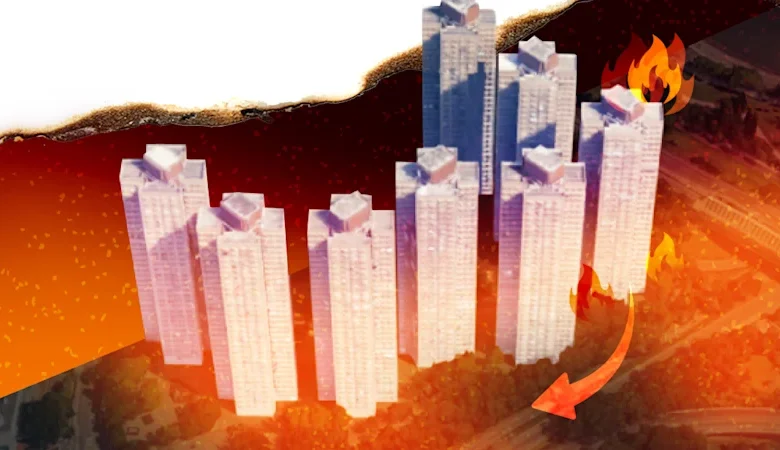Graphics and video show Hong Kong fire’s rapid, deadly spread

Normal text sizeLarger text sizeVery large text size
Hong Kong investigators are piecing together how the city’s worst fire in decades rapidly raged through seven high-rise buildings on Wednesday, leaving at least 94 people dead, dozens injured and scores missing.
As fires smouldered in several apartment blocks at the Wang Fuk Court housing complex on Friday, firefighters continued searching for residents unaccounted for. Extreme heat was hampering rescue efforts, officials said.
The fire at Wang Fuk Court is Hong Kong’s worst fire in decades.Credit: Getty Images
Here is what we know about the blaze and how it spread so quickly.
How did the fire start?
This is not yet known, though the complex was undergoing major renovation work and was covered in bamboo scaffolding and green protective netting. A number of residents had reportedly complained of construction workers smoking cigarettes on site.
The fire broke out at Wang Cheong House, one of eight identical 31-storey residential towers at the Wang Fuk complex, which was built in the 1980s.
The first call to the fire brigade came at 2.51pm, Hong Kong time (5.30pm AEDT).
Social media footage captured the fire’s early stages as green plastic netting and bamboo scaffolding being used in the renovation work rapidly ignited.
The fire spread quickly up the side of the building, and within minutes the entire block was alight.
As it took hold, burning debris began to fall from the building.
Within minutes, fire had spread to seven of the eight buildings, which form a V-shape that extends out towards several other skyscrapers.
Some 750 firefighters tried to quell the flames – but soon the buildings were engulfed, with hundreds of residents trapped inside.
One man told this masthead that no alarm had sounded, and that he had been alerted to the emergency by neighbours banging on his apartment door.
The high temperatures prevented firefighters from entering the buildings to fight the inferno and rescue survivors, said Derek Armstrong Chan, deputy director of Hong Kong’s Fire Service Department.
What caused it to spread so quickly?
Officials are focusing on how the apparently highly flammable green netting and bamboo scaffolding enabled the fire to spread so rapidly up the outside of the buildings.
They also suspect other materials, such as Styrofoam-type panels used to protect windows from damage, did not meet fire-resistance standards.
The windows of many apartments in the complex were reportedly covered with polystyrene foam.Credit: Daniel Ceng / SMH
One Wang Fuk Court resident, Lau Yu Hung, 78, told The New York Times that many of the windows in his block were covered with a thin layer of polystyrene foam.
The material blocked out much of the light and prevented residents from seeing outside, he explained. It was only because of a small gap in the foam covering the bathroom window that he had been able to see that a neighbouring building was on fire and escape in time, he said.
Strong winds also fanned the flames and may have prevented helicopters from being used in the firefighting effort.
According to Bloomberg, inspections had flagged risks well before the disaster. Regulators conducted 16 checks on the renovation project and issued repeated written warnings urging the contractor to put proper fire-prevention measures in place, including as recently as last week, according to Hong Kong’s Labour Department.
Two directors and one engineering consultant from a construction firm had been arrested on suspicion of manslaughter over the fire, Hong Kong Police have said.
What type of buildings were they?
Wang Fuk Court is a complex of privately owned, government-subsidised housing in the Tai Po district of Hong Kong’s New Territories, close to the northern border with mainland China.
Built in the 1980s, the basic apartments measure 40 to 45 square metres, according to online real estate listings. Like most of Hong Kong’s high-density housing, they appear not to have been equipped with smoke detectors or sprinkler systems.
A view of the aftermath of the fire at Wang Fuk Court.Credit: AP
The buildings were also constructed before revisions to the city’s fire codes required mandatory fire refuge floors.
Hong Kong’s 7.5 million residents mostly live in cramped apartments crammed on scarce flat land or perched on the slopes of steep mountainsides. Many of those high-rise buildings are crowded together.
How does this fire compare to Grenfell Tower?
The 2017 Grenfell Tower fire was one of the United Kingdom’s worst modern-day disasters.
Seventy-three people died when a fire, which started in a malfunctioning fridge, engulfed a 23-storey west London tower block, fuelled by flammable metal cladding that had been added to the exterior during renovation work.
A six-year public inquiry eventually exposed a range of regulatory failings of building standards and fire safety stretching back decades. A criminal investigation into a number of organisations, companies and individuals connected to the disaster is ongoing.
The 2017 Grenfell Tower fire.Credit: Evening Standard via Getty Images
In both disasters, graphic imagery quickly captured news feeds around the world. But while they appear to have superficial similarities, there are also significant differences.
In many high-rise buildings, including Grenfell Tower, shelter-in-place (or “stay put”) is a common fire safety standard. However, it becomes ineffective when an unimpeded fire spreads up the outside of a building. This happened at Grenfell Tower and in Hong Kong.
Loading
At Grenfell Tower, the fabric of the building itself – Polyethylene-filled aluminium composite cladding added during renovation work – was found to be the root cause, rather than exterior scaffolding or temporary sheeting.
However, in another possible parallel with Hong Kong, combustible foam insulation added to window frames at Grenfell Tower was found to be a significant factor in helping the fire spread.
Helping the survivors
Hundreds of survivors who were evacuated or were outside the buildings when the fire started have been placed in temporary shelters, including a nearby school.
There, workers were distributing bottled water, food and other necessities. Volunteers were bringing supplies such as water and snacks.
Volunteers help evacuated residents at a nearby shopping mall.Credit: AP
More than 70 people were injured, the city’s Fire Services Department said.
The fire was deadlier than one in November 1996, when 41 people died in a commercial building in Kowloon in a blaze that lasted for around 20 hours. A warehouse fire in 1948 killed 176 people, according to the South China Morning Post.
With AP
Get a note directly from our foreign correspondents on what’s making headlines around the world. Sign up for our weekly What in the World newsletter.





